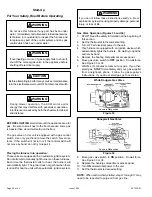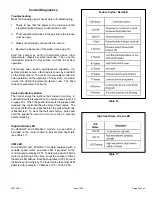
507335-01
Page 33 of 44
Issue 1624
Primary and Secondary Limits
The primary limit is located on the heating compartment
vestibule panel. The secondary limits (if equipped) are
located in the blower compartment, attached to the back
side of the blower. These auto reset limits are factory set
and require no adjustment.
Flame Rollout Switches (Two)
These manually reset switches are located on (or inside of)
the burner box. If tripped, check for adequate combustion
air before resetting.
Pressure Switches
The pressure switch assembly (includes two switches)
is located in the heating compartment adjacent to the
combustion air inducer. These switches check for
proper combustion air inducer operation before allowing
ignition trial. The switches are factory-set and require no
adjustment.
Temperature Rise
Place the unit into operation with a second-stage heating
demand. After supply and return air temperatures have
stabilized, check the temperature rise. If necessary, adjust
the heating blower speed to maintain the temperature rise
within the range shown on the unit nameplate. Increase the
blower speed to decrease the temperature rise. Decrease
the blower speed to increase the temperature rise. Failure
to properly adjust the temperature rise may cause erratic
limit operation.
Thermostat Heat Anticipation
Set the heat anticipator setting (if adjustable) according to
the amp draw listed on the wiring diagram that is attached
to the unit.
NOTE:
Do not secure the electrical conduit directly to the
air ducts or structure.
Sequence of Operation
See figures 33 – 37.
Heating
On a call for heat from the room thermostat, the control board
performs a 1 second self check. Upon confirmation that the
pressure switch contacts are in an open position, the control
energizes the combustion blower on high speed. The control
then checks for adequate combustion air by making sure
the low-fire pressure switch contacts are closed.
The igniter energizes and is allowed to warm up for 20
seconds before the gas valve energizes on 1
st
stage and
burners ignite. 45 seconds after the control confirms ignition
has occurred, the control drops the combustion blower to
low speed.
The circulating blower ramps up to 50% of 1
st
stage heat
speed and operates at that speed for one minute (including
ramp up time), then at 75% of 1
st
stage heat speed for an
additional minute. After that, the circulating blower operates
at full 1
st
stage heat speed until either the heat call is satisfied
or the thermostat initiates a call for 2
nd
stage heat. On a call
for 2
nd
stage heat, the control energizes the circulating air
blower on full CFM 2
nd
stage heat.
If the automatic heat staging option is being used (see Single
Stage Thermostat Operation on page 27), the furnace does
not switch to 2
nd
stage heat in response to a call from the
thermostat but instead operates at 1
st
stage heat for the
duration of the selected time before automatically switching
to 2
nd
stage heat.
When the call for heat is satisfied, the gas valve and
combustion air blower shut down. The control board shuts
off the gas valve and runs the combustion blower for an
additional 15 seconds. The circulating air blower continues
to run for 2 minutes at 82% of the selected heating speed
(low fire or high fire) before ramping down.
In the event the unit loses ignition, the control will attempt to
recycle up to five times before it goes into a 1 hour lockout.
Lockout may be manually reset by removing power from the
control for more than 1 second or removing the thermostat
call for heat for more than 3 seconds.
If during a heating cycle the limit control senses an abnormally
high temperature and opens, the control board de-energizes
the gas valve and the combustion blower while the circulating
blower ramps up to 2
nd
stage heat speed. The circulating
blower remains energized until the limits are closed.
Summary of Contents for 80G2UH-V
Page 29: ...507335 01 Page 29 of 44 Issue 1624 ADJUSTING AIRFLOW Table 11 ...
Page 41: ...507335 01 Page 41 of 44 Issue 1624 Wiring Diagram Figure 41 ...
Page 42: ...507335 01 Page 42 of 44 Issue 1624 Typical Field Wiring Diagram Figure 42 ...
Page 43: ...507335 01 Page 43 of 44 Issue 1624 Start Up Performance Check List UNIT SET UP ...
Page 44: ...507335 01 Page 44 of 44 Issue 1624 UNIT OPERATION ...


























